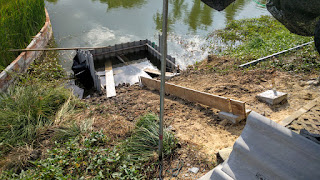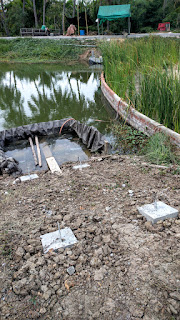I’ve been wanting a way to climb down into the pond for some time now.
After going swimming in the pond a few times (mostly for the purpose of doing maintenance, but it is still refreshing on a hot summer day), it is quite clear that climbing up and down the slope is quite difficult and dirty, particularly the wet muddy parts below the water line.
So the obvious solution to this is a stairway.
We decided to go with a wooden stairway. It will probably last less long than a cement one, but will be nicer and more rustic. The wood craftsman we hired is pretty confident that the staircase will last at least 10 years or more if we use good quality “mai teng” wood. And we’ll cover it in many thick layers of polyurethane lacquer to help with the water protection. (Not sure how long this coating lasts.)
For an interesting point of comparison, there was an old wooden pavilion on our land when we bought it. It was sitting in the water for what we believe is about 30 years without any maintenance or care. The wood wasn’t in perfect condition, of course, but it was still standing. And we are using some of those old pieces of wood around the land to make benches, etc. So the idea that a wooden staircase down into water could last a decade or more isn’t too unbelievable.
Unfortunately, it would have been much easier to construct this staircase before the water level in the pond rose above the bottom height of the stairs. My excuse is that so much of the pond is a first for me and there are so many obvious priorities that I’ve pretty well given up on trying to do everything. So now we have to make modifications as needed when we find something we regret not doing. :-/
In the end, I decided on two staircases, one on the west side of the pond and the other on the east. Besides being a way to climb into and out of the pond for swimming, I’m hoping these staircases will also be usable as a sort of docking point for our little ferry boat to move around the pond and do maintenance as well as ferry us out to the floating house (BaanLoiNaam) once it is built. I haven’t exactly figured out how this docking mechanism will work, but let’s deal with one thing at a time.
So we had to figure out how to move the water out of the way for the construction of the staircase, but the workers seemed to know what they were about. First, the workers bought some simple roof tiles and built a cheap eucalyptus wood support structure to make a water wall in the pond. Then they covered this wall with a waterproof canvas on the outside. Finally, they pumped the water from the inside of this structure out into the pond and left the pump running while they worked since the structure will of course leak.
Here is a picture of this in action:
If you look carefully, you can see the pump in the upper right of the enclosed area.
That picture was taken a little over a week ago. On last Sunday, I took a picture of the two staircases being built. Besides the water wall at the bottom, they’ve dropped in 6 pilings and built cement footings on top of them. Coming out of the cement footings, they installed bars of stainless steel for mounting the side part of the stairways. Here is the east staircase under construction:
(Note that being Sunday, the workers aren’t working, so the pump was off and the water filled back in.)
And a picture of the west one across the pond:
The green tarp roof on the other side of the pond is where the east side staircase is being built. It is for shade for the workers as they work on the east side staircase.
Unrelated side note: a few months back, we planted just 4 or 5 shoots of the tall grasses you can see in the sand filtration area by the wall on the right side of this image. Since then, they have multiplied quite nicely into a wall of grass behind the wall of brick. The principal is that once the water level rises above the wall and the full circulation path is functioning, the bacteria layer that will grow on the top of the sand will consume most or all of the nutrients in the water and then the plants will use those nutrients to grow themselves. And look nice. By trimming the plants regularly, we will be able to remove much of these nutrients from the pond ecosystem as a whole, hopefully starving the water of nutrients to the point where even algae can’t grow. That should help the water become more clear and beautiful.
So the property of the grass being able to grow and multiply quickly without much maintenance should become a useful asset in this experiment.


